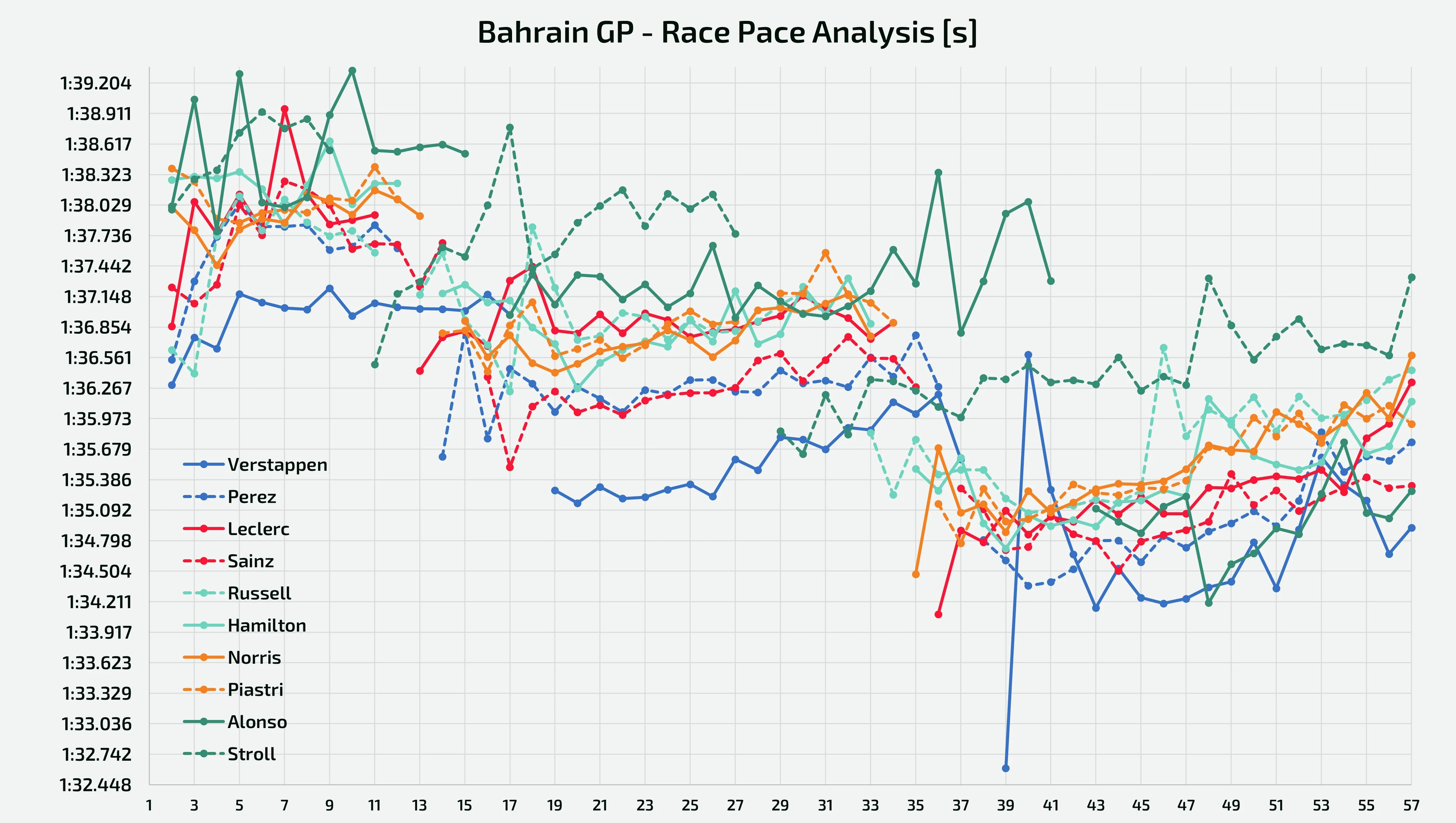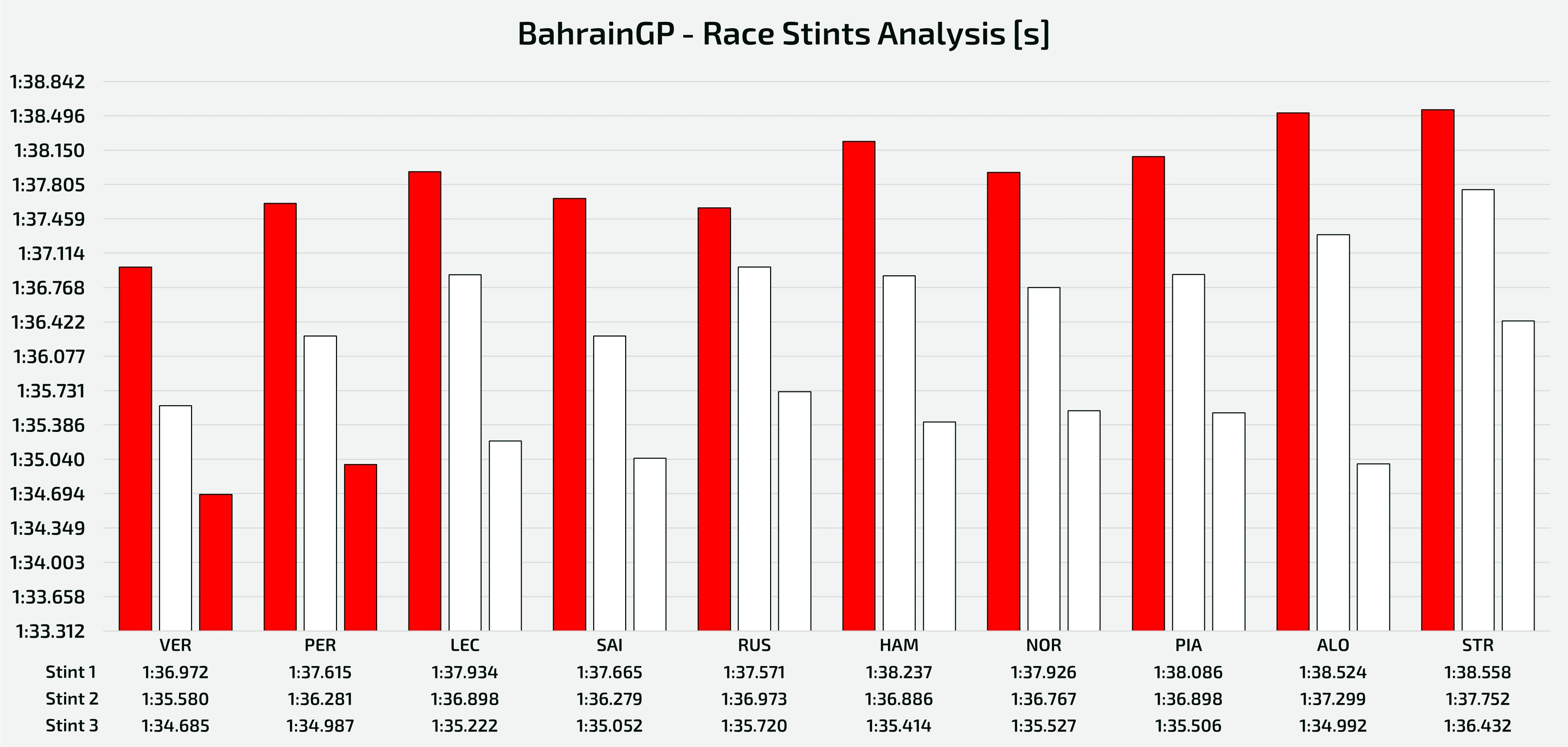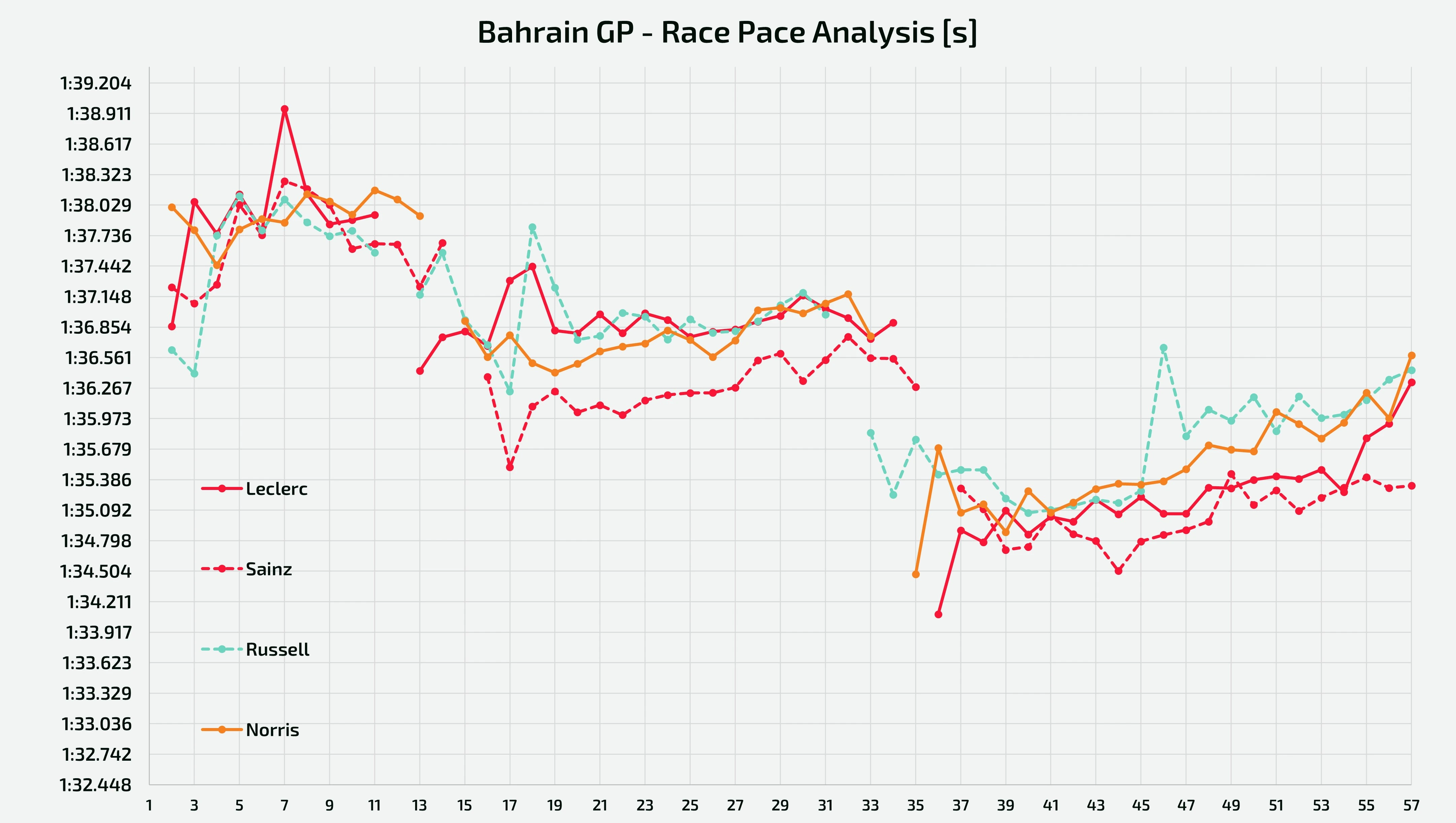
Max is already on the move. But rivals make life difficult for themselves in Bahrain...
The 2024 Formula 1 World Championship starts, it must be said, exactly in the same way as 2023 ended: with an uncontested race win for Max Verstappen, who this time even brings home the so-called "Grand Chelem" (pole position, victory, fastest lap of the race, with all laps in the lead). It hasn't happened since 2004 that a similar feat was accomplished at the first Grand Prix of the season, but as said yesterday after qualifying, I feel that we should be cautious in considering this Championship as closed before it has even begun...
RACE CLASSIFICATION (LAP 57/57)
— Formula 1 (@F1) March 2, 2024
Verstappen notches career win No. 55 👏👏👏#F1 #BahrainGP pic.twitter.com/E8yh7MjVP6
So with the help of telemetry data, let's try to give an understanding of this Bahrain GP!
A dominant Verstappen , but what's the real performance of Ferrari and Mercedes?
The first race of the year sounds like a wake-up call both for all the teams other than Red Bull and for the fans who dreamed of seeing once again battles for victory as heated as in the past. But as I said, however, with a close starting grid like the one we've seen, it's unlikely that we'll hear the combination of the Dutch and Austrian anthem on the podium all year long.
Sam Bloxham / Motorsport Images
Let's take as an example the race pace kept by the first 10 at the finish line (which, without any retirements, actually were the 10 cars of the 5 best teams - Red Bull, Ferrari, Mercedes, McLaren, Aston Martin):

Analysis of the race pace held by the top 10 at the finish line
Verstappen's solid blue line is constant and consistently lower than everyone else, which wipes out any doubt about the competitiveness of him and the RB20. But from the same graph it can be seen that from lap 4 onwards, behind Max the lines of the other drivers tend to rise and intersect: what does it mean?
Well, mainly that almost everyone (Russell, Leclerc, Sainz and Perez) lost a lot of time battling each other, a circumstance in which they were unable to drive in clean air. This sequence of slow-ish laps was mainly triggered by the brake issue suffered by Charles Leclerc, who in fact slipped back from second to fifth position during the first stint.
Andy Hone / Motorsport Images
There is currently no further information on the nature of this problem, except that before the start of the Grand Prix Ferrari had been permitted (by the FIA) the replacement of the left front brake duct of Leclerc's SF-24. An exception that's a rather common procedure, but which in retrospect makes us think, given the problems he then had.
Sam Bloxham / Motorsport Images
In particular, Charles complained about having a car that tended to pull to the right in braking zones. Leaving aside the implications in terms of safety that this may have, the interesting thing to note is how this brake issue manifested: frequent front locking in the most demanding braking zones of the circuit, especially in Turn 1 and Turn 10. The reason lies in the fact that when a single-seater pulls to the right (in this particular case) instead of allowing braking with straight wheels, the opposite wheel (the front left) is further loaded, reaching its grip limit before the front right tyre...
This imbalance feeds on itself, because the less loaded wheel cannot provide the grip of its tyre to "stop" the car at the apex. Hence the conspicuous front lockings that often led to the overtaking suffered by the Monegasque often and (un)willingly.

Analysis of the race stints completed by the top 10 at the finish line
Having analyzed the technical problem itself, on a performance point of view it should be noted how Leclerc literally learned over the course of the laps to manage the new "lopsided" balance of his SF-24: by his own admission in the press conference, he had to use the brake balance and differential settings in a weird manner, for the sole purpose of minimizing the unbalance between the left and right wheel of his single-seater.
As can be seen from the cumulative analysis of the three stints in which all the front runners decided to divide their race, if we compare the pace kept by Leclerc against the "healthy" Ferrari of his teammate Sainz, the average gaps are the following:
- Stint 1: -0.269 s/lap in favour of Sainz;
- Stint 2: -0.619 s/lap in favour of Sainz;
- Stint 3: -0.170 s/lap in favour of Sainz;
Between the first and last stint there's a recovery of about a tenth per lap by Leclerc on Sainz, proving what has just been said. From this perspective, you might ask what happened in the middle part of the race, covered by both Ferrari drivers on Hard tyres... The gap of over 6 tenths per lap in favour of Carlos was in fact spoiled by a stint run by Leclerc closely behind George Russell's Mercedes, slower than his SF-24 but difficult to attack due to the already mentioned brake issue.

Analysis of the race pace of Sainz (P3), Leclerc (P4), Russell (P5) and Norris (P6)
In fact, if we extend the comparison between the Ferrari drivers also to Russell himself and Lando Norris' McLaren, we can see how throughout the middle part of the race George slowed down those following him, causing Leclerc and the Englishman from McLaren to join the pack, as well as Sainz pulling away in front of them all.
The Mercedes driver today set a pace that - according to him - didn't show the real potential of his W15: the reason lies in an incorrect choice of the cooling configuration at the rear. In a nutshell, choosing an engine cover that is too narrow has had the negative effect of "trapping" the hot air which should instead be ejected; this calculation error, if we want to call it that, was born from the need of the English-German engineers to maximize aerodynamic efficiency... But they exceeded on this quest, and the above-mentioned overheating issues in turn forced Russell to use conservative Power Unit settings. In addition to this, it was curious to see - during the overtaking suffered by Sainz - that his W15 was losing an excessive quantity of engine oil, but we cannot know whether this was due to an excessive filling before the race or a contributing cause of the engine settings adopted.
Steve Etherington / Motorsport Images
Toto Wolff, at the end of the race, quantified the time loss caused by this issue at almost half a second per lap. If this were to be true, all other conditions being equal we can assume with some certainty that Russell would have finished in second place today; personally I believe that Leclerc would have been even stronger in terms of race pace without his misadventures, but the fact remains that in Formula 1 to achieve the desired results (which currently means beating Verstappen and Red Bull) you also need to be good in the off-track choices, and in one way or another today at Ferrari and Mercedes they weren't...

Race pace comparison at Mercedes between Russell (P5) and Hamilton (P7)
As a corollary to what was said in commenting on George Russell's race, the comparison on the race pace with his teammate Lewis Hamilton, who started significantly further behind him, might prove useful. As can be seen, as the laps went by, Hamilton was able to take greater advantage of running in clean air - something that was not possible in the first stint, which was also the only one run on Soft tyres.
All this, looking at the graph above relating to the cumulative analysis of the stints, translates into the following situation:
- Stint 1: -0.666 s/lap in favour of Russell;
- Stint 2: -0.087 s/lap in favour of Hamilton;
- Stint 3: -0.306 s/lap in favour of Hamilton;
Mark Sutton / Motorsport Images
The day's haul sees only 16 points for the team from Brackley, which represents a deficit of 11 points from their designated rivals Ferrari; on the other hand, there are already 4 points more than McLaren in the standings, all gained thanks to Hamilton's decisive overtaking on Oscar Piastri - while the latter left the pits after his second and final stop. But these are only the first indications on the rankings of a World Championship that is expected to be neverending, with its 24 races...
The race outside the points rewards Zhou and Magnussen, while RB and Alpine disappoint
Starting from the eleventh position we find a bunch of cars separated by small gaps, except for the last two classified drivers Bottas (which unfortunately had a slow pit stop of 52.4 s) and Sargeant (who in the middle of the race suffered an electronic problem for which a reset and then a steering wheel change in the pits were necessary).
Zak Mauger / Motorsport Images
Those who ran a masterful race were, in my opinion, Guanyu Zhou on the other Stake and Kevin Magnussen on his Haas. The first of the two even found himself in points paying positions for most of the race, although this position was somewhat inherited from the misfortunes of Lance Stroll, hit at the start by Nico Hulkenberg's Haas, but who then recovered to finish in tenth place.
Honestly, I wouldn't have expected a Stake on the edge of the top ten, and the same goes for Haas. The suspicion remains that these performances were favoured more than anything else by demerits of other teams, namely Williams and Alpine: the French team itself proved to be - as in qualifying - the slowest of the lot, and frankly it's difficult to comment on a race in which the gap from the second last car in terms of race pace (i.e. Williams) was around 20 seconds over the 57 laps...
Straight to Saudi Arabia for the second stage of the 2024 World Championship!
Not even time for the teams to organize their thoughts after the inaugural Grand Prix in Bahrain, and Formula 1 immediately goes to Jeddah, for a second round of the Championship which will once again host the race on Saturday - again for religious reasons. Last year we witnessed one of the clearest test of strength from Red Bull, with a Perez-Verstappen one-two in which the latter recovered in just 25 laps starting from fifteenth position (due to a driveshaft issue in qualifying, during Q2) .
Sam Bloxham / Motorsport Images
Jeddah is a circuit with very different characteristics compared to Sakhir, and this will constitute a very interesting backtest to understand what the gap between Ferrari and Mercedes and Red Bull could be on a high-speed layout, usually with skyrocketing ambient temperatures. As you may have understood, I'm expecting a smaller gap than the one seen in today's race: if this prediction of mine were to be confirmed, it will be an important step towards a more competitive World Championship...
Index
Max is already on the move. But rivals make life difficult for themselves in Bahrain...